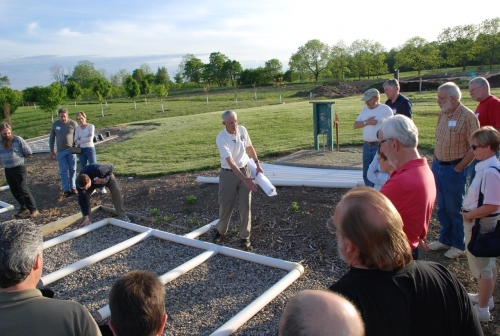Managing household wastewater in sensitive shoreline areas
Important recommendations for shoreline homeowners with septic systems
Shoreline residents have a special role in preventing contamination of Michigan’s water resources. An individual’s actions on or around their property can affect not only their water quality but also that of their neighbors and those in other parts of the watershed. Often, activities on shoreline properties have a higher likelihood of polluting water.
For example, maintaining a septic system (both the septic tank and its drain-field) located near the shoreline requires more care than a similar system located away from a body of surface water. The need to properly care for a septic system is even greater due to the potential negative impacts it may cause on our health since many who have septic systems often also have drinking water wells.
Soil type and nearness to both groundwater and surface water are two significant factors that can increase the risk of potential contamination from shoreline septic systems. Septic systems in clay soils have a higher risk of clogging and failing which potentially can cause nutrients and contaminants running off to the shore. Very sandy soils may also allow nutrients to move quickly down to groundwater before they are properly processed in the soil. Because shoreline areas typically have high water tables and septic systems are often very close to the water, the potential to negatively impact groundwater and/or surface water is significant. Often, native plants and wetlands have been replaced with lawns, beaches, and seawalls, and thus pollutants have less chance of being filtered thoroughly before reaching the water. Finally, shoreline erosion can also shorten the distance between the septic system and the water’s edge. This decreased area may lead to inadequate area to properly treat wastewater before it moves into surface water and/or groundwater.
Given these factors, a septic system that is properly installed and managed can process household wastewater in a simple, economical, effective, and safe way for a long time. Here are some special considerations for those who have septic systems in shoreline areas, to protect their family and the health of nearby water resources, and to reduce the risk of contaminating nearby water resources:
- Have your septic tank inspected and pumped regularly by a licensed pumper. The general recommendation of how often to get your tank pumped is about once every 3-5 years. Of course, the right specific pumping schedule for you is based on the size of the septic tank, the number of individuals in your household and the amount of wastewater generated.
- Consider improving or upgrading your system if the amount of wastewater you generate is more than your septic system can handle. Since it is not easy to make such extensive changes, carefully consider all of the activities that generate wastewater in your home—cooking, bathing, flushing toilets, laundry, dishwasher, etc. This will help you come up with measures you can take to conserve water as much as possible.
- Install a vegetative buffer strip of deep-rooted plants between the end of your drain-field and the shoreline area. These plants can help absorb nutrients before they reach water. Take care not to plant deep-rooted plants in the area directly over your drain-field, as roots might cause damage to your system, which may result in wastewater that is not adequately treated.
- Construct the septic system as far away from the shoreline as possible if you are building a new home. Check with the local health department to determine specific requirements.
- Consider alternatives to a traditional septic system such as hooking up to a community sewage system or alternative disposal method. Check with the local health department to determine what options are possible.
Photo: MSU Professor Emeritus Dr. Ted Loudon gives tour of Onsite Wastewater Management Area at MSU Tollgate Education Center, Novi, MI
An excellent resource to help determine your risk of contributing to shoreline contamination is the MSU Extension Bulletin Managing Shoreline Property to Protect Water Quality (WQ-52). The Home*A*Syst Guide (WQ-51) can also help assess your potential for environmental risks in and around your home. Both are available through the MSU Extension Bookstore.



 Print
Print Email
Email




